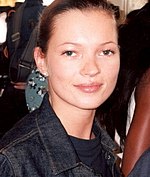
Katherine Ann Moss is an English model. Arriving towards the end of the "supermodel era", Moss rose to fame in the early 1990s as part of the heroin chic fashion trend. Her collaborations with Calvin Klein brought her to fashion icon status. She is known for her waifish figure, and role in size zero fashion. Moss has had her own clothing range, has been involved in musical projects, and is also a contributing fashion editor for British Vogue. In 2012, she came second on the Forbes top-earning models list, with estimated earnings of $9.2 million in one year. The accolades she has received for modelling include the 2013 British Fashion Awards acknowledging her contribution to fashion over 25 years, while Time named her one of the world's 100 most influential people in 2007.

Lee Alexander McQueen was a British fashion designer and couturier. He founded his own Alexander McQueen label in 1992, and was chief designer at Givenchy from 1996 to 2001. His achievements in fashion earned him four British Designer of the Year awards, as well as the Council of Fashion Designers of America International Designer of the Year award in 2003. McQueen died by suicide in 2010 at the age of 40, at his home in Mayfair, London, shortly after the death of his mother.
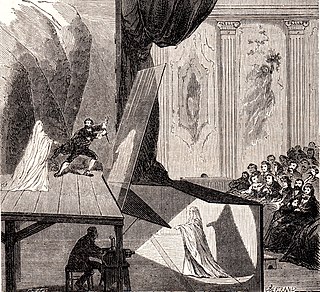
Pepper's ghost is an illusion technique, used in the theatre, cinema, amusement parks, museums, television, and concerts, in which an image of an object off-stage is projected so that it appears to be in front of the audience.
Alexander McQueen is a British luxury fashion house founded by the designer Alexander McQueen in 1992. After his death, Sarah Burton was its creative director, from 2010 to 2023. Its current creative director is Seán McGirr. The house specializes in haute couture, ready-to-wear, premium leather accessories, and footwear.
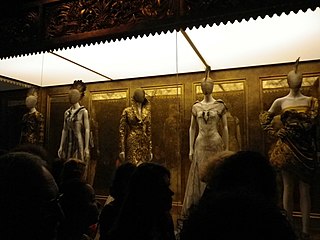
Alexander McQueen: Savage Beauty was an art exhibition held in 2011 at the Metropolitan Museum of Art featuring clothing created by British fashion designer Alexander McQueen, as well as accessories created for his runway shows. The exhibit was extremely popular in New York City and resulted in what was then record attendance for the museum. The curators were Andrew Bolton and Harold Koda.

The armadillo shoe is a high fashion platform shoe created by British fashion designer Alexander McQueen for his final collection, Plato's Atlantis. Only 24 pairs exist: 21 were made during the initial production in 2009, and three were made in 2015 for a charity auction. The shoes are named for their unusual convex curved shape, said to resemble an armadillo. Each pair is approximately 12 inches (30 cm) from top to sole, with a 9-inch (23 cm) stiletto heel; this extreme height caused some models to refuse to walk in the Plato's Atlantis show. American singer Lady Gaga famously wore the shoes in several public appearances, including the music video for her 2009 single "Bad Romance".

The Widows of Culloden is the twenty-eighth collection by British fashion designer Alexander McQueen, made for the Autumn/Winter 2006 season of his eponymous fashion house. It was inspired by his Scottish ancestry and is regarded as one of his most autobiographical collections. It is named for the widows of the Battle of Culloden (1746), often seen as a major conflict between Scotland and England. Widows makes extensive use of the McQueen family tartan and traditional gamekeeper's tweeds, as well as other elements taken from Highland dress. Historical elements reflected the fashion of the late Victorian era and the 1950s.
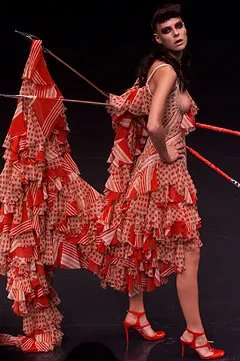
The Dance of the Twisted Bull is the nineteenth collection by British designer Alexander McQueen for his eponymous fashion house. Twisted Bull was inspired by Spanish culture and art, especially the traditional clothing worn for flamenco dancing and bullfighting. In McQueen's typical fashion, the collection included sharp tailoring and historicist elements and emphasised femininity and sexuality.

The Birds is the fifth collection by British designer Alexander McQueen for his eponymous fashion house. The Birds was inspired by ornithology, the study of birds, and the 1963 Alfred Hitchcock film The Birds, for which it was named. Typically for McQueen in the early stages of his career, the collection centred around sharply tailored garments and emphasised female sexuality. McQueen had no financial backing, so the collection was created on a minimal budget.

Neptune is the twenty-seventh collection by British designer Alexander McQueen for his eponymous fashion house. It took inspiration from classical Greek clothing, 1980s fashion, and the work of artists influential in that decade. The runway show was staged during Paris Fashion Week on 7 October 2005 at the industrial warehouse of the Imprimerie Nationale. Two main phases were presented, with 56 looks total: the first phase comprised monochrome black clothing, while the second featured a white, green, and gold palette. The collection's clothing and runway show both lacked McQueen's signature theatricality, and critical reception at launch and in retrospect was negative. Items from Neptune appeared in the 2022 exhibition Lee Alexander McQueen: Mind, Mythos, Muse.

Irere was the twenty-first collection by British fashion designer Alexander McQueen for his eponymous fashion house. Irere was inspired by imagery from the Age of Discovery and from the people and animals of the Amazon rainforest. Its title is claimed to mean 'transformation' in an unspecified Indigenous Amazonian language. The collection comprised three distinct concepts presented as a narrative sequence: shipwrecked pirates, menacing conquistadors, and tropical birds. McQueen described the collection as an effort to present a more mature point of view and surprise viewers with bold colours.

The oyster dress is a high fashion gown created by British fashion designer Alexander McQueen for his Spring/Summer 2003 collection Irere. McQueen's design is a one-shouldered dress in bias-cut beige silk chiffon with a boned upper body and a full-length skirt consisting of hundreds of individual circles of organza sewn in dense layers to the base fabric, resembling the outside of an oyster shell. According to McQueen, the gown took a month's work for three people, who cut and assembled all the pieces individually. In addition to the original beige dress, a version with a red bodice and the ruffled skirt in rainbow colours was also created. The beige and red versions appeared in the Irere runway show, and were photographed for magazines to promote the collection.
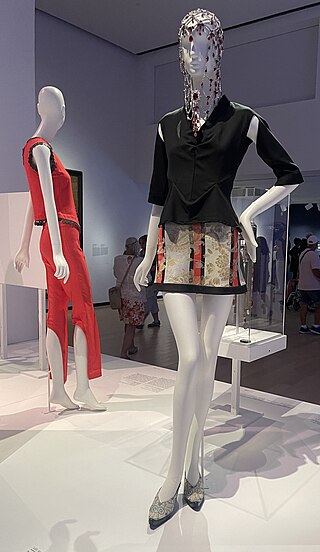
Eye was the fifteenth collection by British fashion designer Alexander McQueen for his eponymous fashion house. It was inspired by the culture of the Middle East, particularly Islamic clothing, as well as the oppression of women in Islamic culture and their resistance to it. The collection crossed traditional Middle Eastern garments with elements drawn from Western fashion such as sportswear and fetishwear. Jeweller and frequent McQueen collaborator Shaun Leane provided the collection's best-known design: a yashmak made from chainmail.
No. 13 Finale is a performance artwork by fashion designer Alexander McQueen, presented at the end of the Spring/Summer 1999 show for McQueen's eponymous fashion house. It consists of model Shalom Harlow wearing a white dress, standing on a rotating platform on the show's catwalk and being spray-painted by robots.
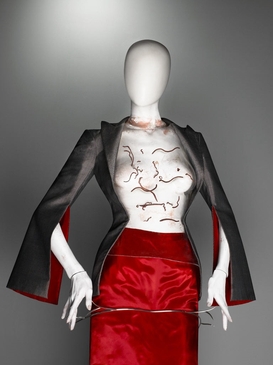
The Hunger is the seventh collection by British designer Alexander McQueen for his eponymous fashion house. The collection was primarily inspired by The Hunger, a 1983 erotic horror film about vampires. McQueen had limited financial backing, so the collection was created on a minimal budget. Typically for McQueen in the early stages of his career, the collection centred around sharply tailored garments and emphasised female sexuality. It was his first collection to include menswear.

The Overlook was the fourteenth collection by British fashion designer Alexander McQueen for his eponymous fashion house. It was inspired by the Stanley Kubrick horror film The Shining (1980) and named for the fictional Overlook Hotel where much of the film takes place. The collection focused on winter clothing in light and neutral colours, including chunky knitwear, fur and shearling coats, and parkas inspired by Inuit clothing. Showpiece items included a bustier made from rock crystal and a corset made from coils of aluminium, the latter provided by jeweller and frequent McQueen collaborator Shaun Leane.

Pantheon ad Lucem is the twenty-fourth collection by British designer Alexander McQueen for his eponymous fashion house. Inspired by ideas of rebirth, ancient Greek garments and science fiction films including 2001: A Space Odyssey (1968) and Star Wars (1977), the collection focused on sleek draped, wrapped, or tied jersey designs in light and neutral colours, with some evening wear in darker colours. Contrasting the slimline items were heavier garments including tweed suits and fur coats. McQueen expressed his fascination with altering the silhouette, emphasising the hips to a degree that was uncommon for him.

The Girl Who Lived in the Tree is the thirty-second collection by British fashion designer Alexander McQueen, made for the Autumn/Winter 2008 season of his eponymous fashion house. The primary inspirations were British culture and national symbols, particularly the British monarchy, as well as the clothing of India during the British Raj. The collection was presented as a fairy tale about a feral girl who lived in a tree before falling in love with a prince and descending to earth to become a princess, and the runway show was divided into two phases to represent this narrative. In the first phase, the ensembles were all in black and white, with most looks having a slim, tailored silhouette. The clothing from the second half was richly coloured, with luxurious materials and embellishments, representing the girl's transformation into a princess.

Joan was the twelfth collection by British fashion designer Alexander McQueen for his eponymous fashion house. Continuing McQueen's dual fascination with religion and violence, it was inspired by imagery of persecution, most significantly the 1431 martyrdom of French Catholic saint Joan of Arc, who was burned at the stake. The collection's palette was mainly red, black, and silver, colors which evoked notions of warfare, death, blood, and flames. Many items referenced ecclesiastical garments and medieval armour, including several items that mimicked chainmail and one look that had actual silver-plated armour pieces.

